Section 300 of Criminal Code Act, 1899 | Criminal Law
VerifiedAdded on 2022/09/02
|16
|2874
|25
AI Summary
Contribute Materials
Your contribution can guide someone’s learning journey. Share your
documents today.
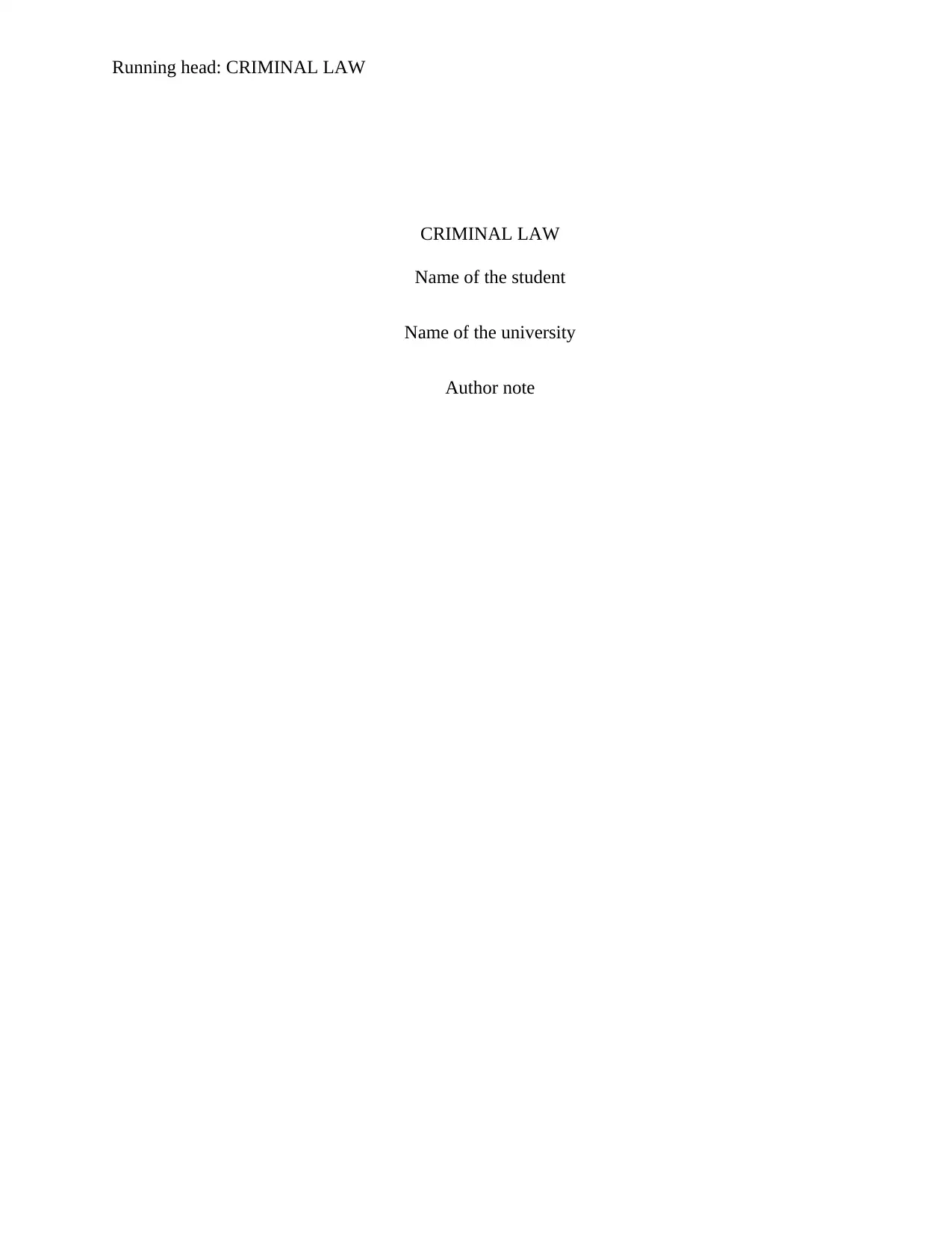
Running head: CRIMINAL LAW
CRIMINAL LAW
Name of the student
Name of the university
Author note
CRIMINAL LAW
Name of the student
Name of the university
Author note
Secure Best Marks with AI Grader
Need help grading? Try our AI Grader for instant feedback on your assignments.
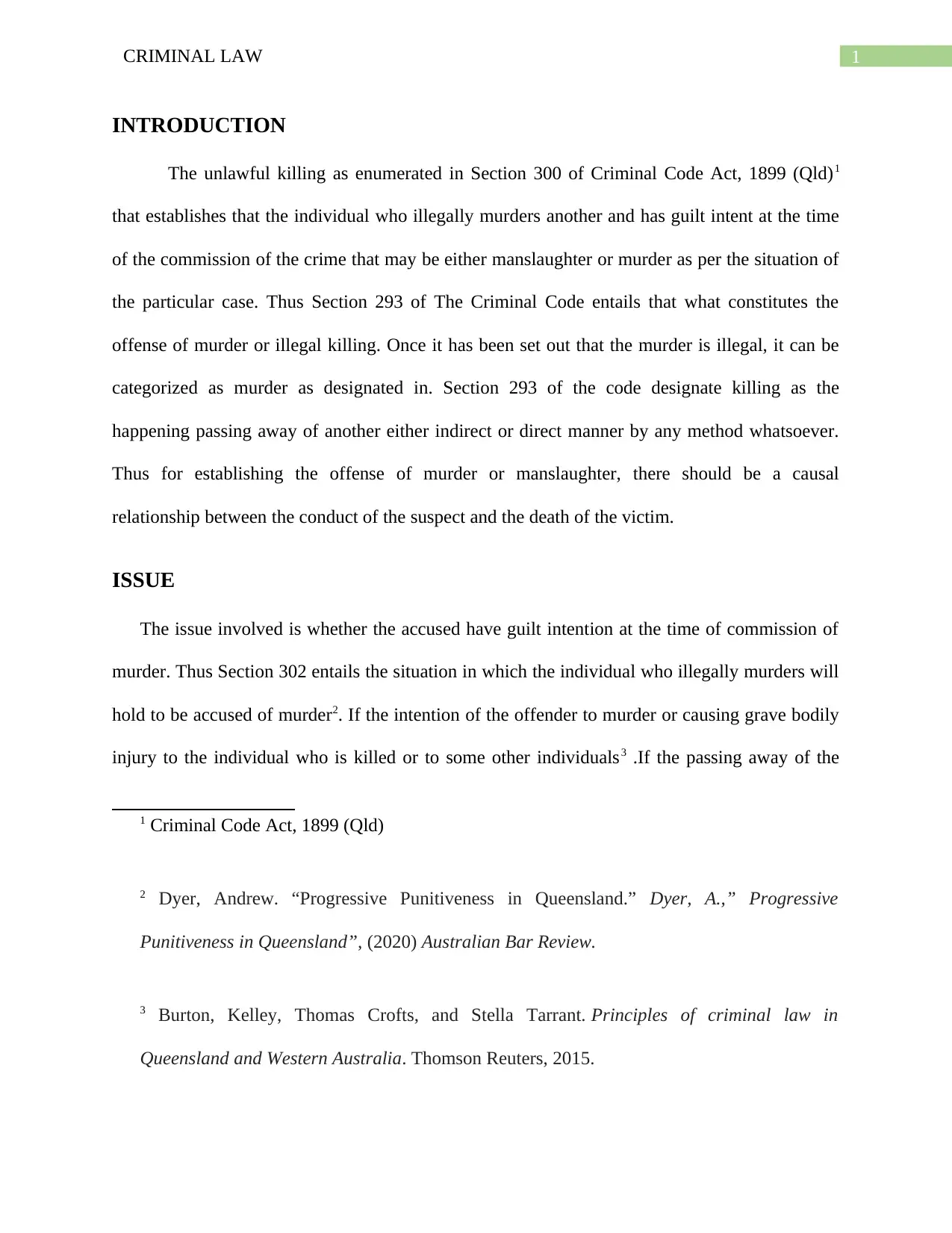
1CRIMINAL LAW
INTRODUCTION
The unlawful killing as enumerated in Section 300 of Criminal Code Act, 1899 (Qld)1
that establishes that the individual who illegally murders another and has guilt intent at the time
of the commission of the crime that may be either manslaughter or murder as per the situation of
the particular case. Thus Section 293 of The Criminal Code entails that what constitutes the
offense of murder or illegal killing. Once it has been set out that the murder is illegal, it can be
categorized as murder as designated in. Section 293 of the code designate killing as the
happening passing away of another either indirect or direct manner by any method whatsoever.
Thus for establishing the offense of murder or manslaughter, there should be a causal
relationship between the conduct of the suspect and the death of the victim.
ISSUE
The issue involved is whether the accused have guilt intention at the time of commission of
murder. Thus Section 302 entails the situation in which the individual who illegally murders will
hold to be accused of murder2. If the intention of the offender to murder or causing grave bodily
injury to the individual who is killed or to some other individuals3 .If the passing away of the
1 Criminal Code Act, 1899 (Qld)
2 Dyer, Andrew. “Progressive Punitiveness in Queensland.” Dyer, A.,” Progressive
Punitiveness in Queensland”, (2020) Australian Bar Review.
3 Burton, Kelley, Thomas Crofts, and Stella Tarrant. Principles of criminal law in
Queensland and Western Australia. Thomson Reuters, 2015.
INTRODUCTION
The unlawful killing as enumerated in Section 300 of Criminal Code Act, 1899 (Qld)1
that establishes that the individual who illegally murders another and has guilt intent at the time
of the commission of the crime that may be either manslaughter or murder as per the situation of
the particular case. Thus Section 293 of The Criminal Code entails that what constitutes the
offense of murder or illegal killing. Once it has been set out that the murder is illegal, it can be
categorized as murder as designated in. Section 293 of the code designate killing as the
happening passing away of another either indirect or direct manner by any method whatsoever.
Thus for establishing the offense of murder or manslaughter, there should be a causal
relationship between the conduct of the suspect and the death of the victim.
ISSUE
The issue involved is whether the accused have guilt intention at the time of commission of
murder. Thus Section 302 entails the situation in which the individual who illegally murders will
hold to be accused of murder2. If the intention of the offender to murder or causing grave bodily
injury to the individual who is killed or to some other individuals3 .If the passing away of the
1 Criminal Code Act, 1899 (Qld)
2 Dyer, Andrew. “Progressive Punitiveness in Queensland.” Dyer, A.,” Progressive
Punitiveness in Queensland”, (2020) Australian Bar Review.
3 Burton, Kelley, Thomas Crofts, and Stella Tarrant. Principles of criminal law in
Queensland and Western Australia. Thomson Reuters, 2015.
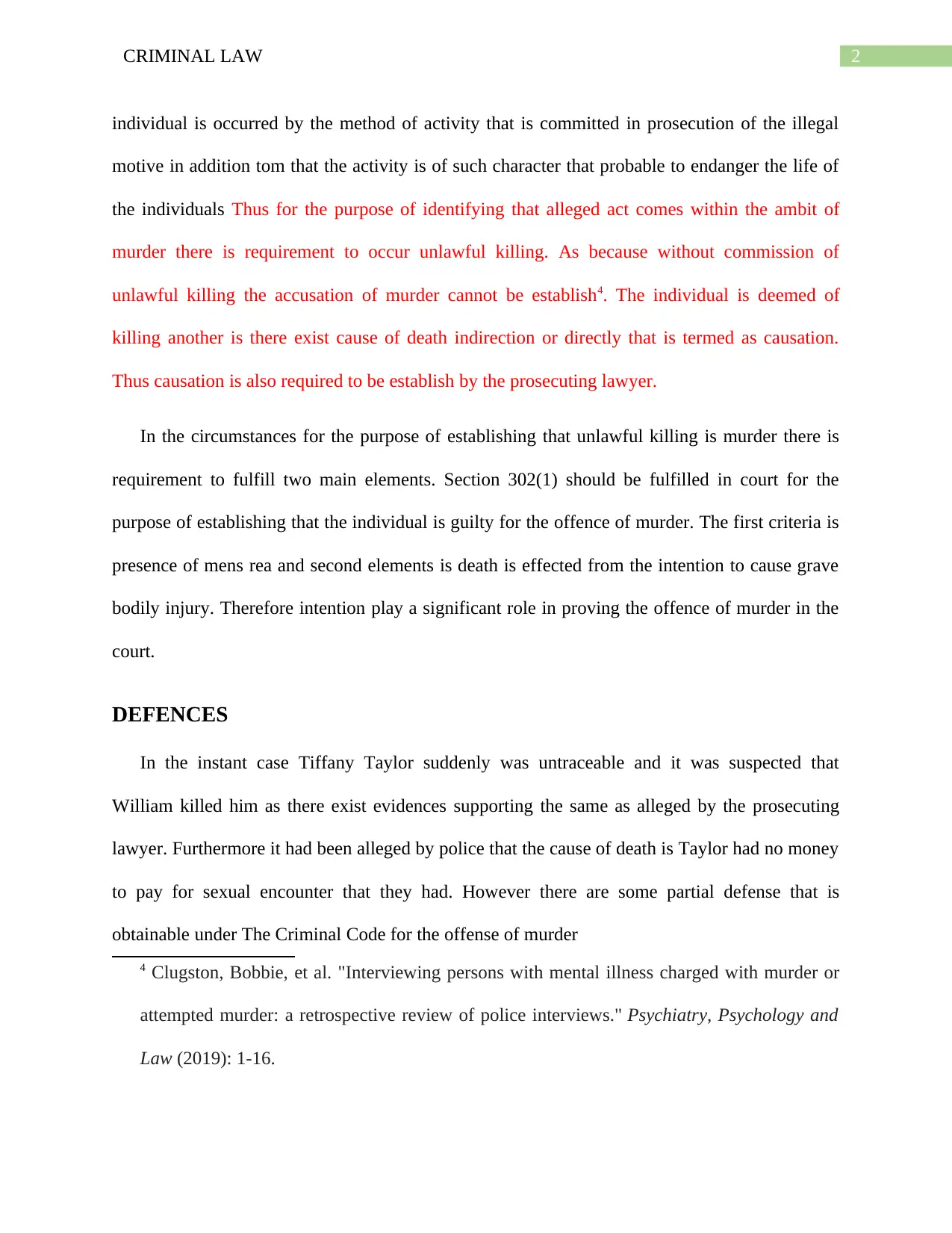
2CRIMINAL LAW
individual is occurred by the method of activity that is committed in prosecution of the illegal
motive in addition tom that the activity is of such character that probable to endanger the life of
the individuals Thus for the purpose of identifying that alleged act comes within the ambit of
murder there is requirement to occur unlawful killing. As because without commission of
unlawful killing the accusation of murder cannot be establish4. The individual is deemed of
killing another is there exist cause of death indirection or directly that is termed as causation.
Thus causation is also required to be establish by the prosecuting lawyer.
In the circumstances for the purpose of establishing that unlawful killing is murder there is
requirement to fulfill two main elements. Section 302(1) should be fulfilled in court for the
purpose of establishing that the individual is guilty for the offence of murder. The first criteria is
presence of mens rea and second elements is death is effected from the intention to cause grave
bodily injury. Therefore intention play a significant role in proving the offence of murder in the
court.
DEFENCES
In the instant case Tiffany Taylor suddenly was untraceable and it was suspected that
William killed him as there exist evidences supporting the same as alleged by the prosecuting
lawyer. Furthermore it had been alleged by police that the cause of death is Taylor had no money
to pay for sexual encounter that they had. However there are some partial defense that is
obtainable under The Criminal Code for the offense of murder
4 Clugston, Bobbie, et al. "Interviewing persons with mental illness charged with murder or
attempted murder: a retrospective review of police interviews." Psychiatry, Psychology and
Law (2019): 1-16.
individual is occurred by the method of activity that is committed in prosecution of the illegal
motive in addition tom that the activity is of such character that probable to endanger the life of
the individuals Thus for the purpose of identifying that alleged act comes within the ambit of
murder there is requirement to occur unlawful killing. As because without commission of
unlawful killing the accusation of murder cannot be establish4. The individual is deemed of
killing another is there exist cause of death indirection or directly that is termed as causation.
Thus causation is also required to be establish by the prosecuting lawyer.
In the circumstances for the purpose of establishing that unlawful killing is murder there is
requirement to fulfill two main elements. Section 302(1) should be fulfilled in court for the
purpose of establishing that the individual is guilty for the offence of murder. The first criteria is
presence of mens rea and second elements is death is effected from the intention to cause grave
bodily injury. Therefore intention play a significant role in proving the offence of murder in the
court.
DEFENCES
In the instant case Tiffany Taylor suddenly was untraceable and it was suspected that
William killed him as there exist evidences supporting the same as alleged by the prosecuting
lawyer. Furthermore it had been alleged by police that the cause of death is Taylor had no money
to pay for sexual encounter that they had. However there are some partial defense that is
obtainable under The Criminal Code for the offense of murder
4 Clugston, Bobbie, et al. "Interviewing persons with mental illness charged with murder or
attempted murder: a retrospective review of police interviews." Psychiatry, Psychology and
Law (2019): 1-16.
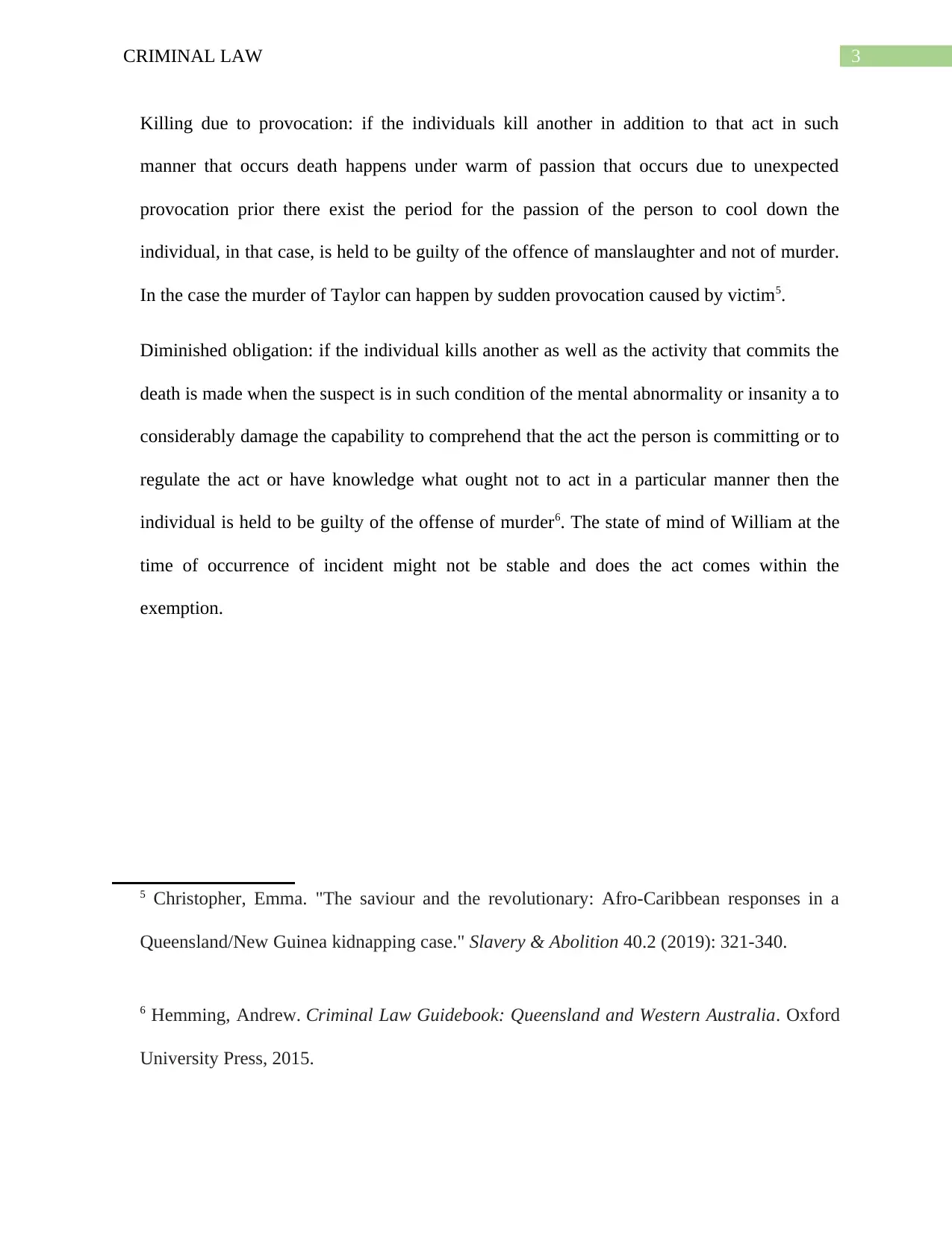
3CRIMINAL LAW
Killing due to provocation: if the individuals kill another in addition to that act in such
manner that occurs death happens under warm of passion that occurs due to unexpected
provocation prior there exist the period for the passion of the person to cool down the
individual, in that case, is held to be guilty of the offence of manslaughter and not of murder.
In the case the murder of Taylor can happen by sudden provocation caused by victim5.
Diminished obligation: if the individual kills another as well as the activity that commits the
death is made when the suspect is in such condition of the mental abnormality or insanity a to
considerably damage the capability to comprehend that the act the person is committing or to
regulate the act or have knowledge what ought not to act in a particular manner then the
individual is held to be guilty of the offense of murder6. The state of mind of William at the
time of occurrence of incident might not be stable and does the act comes within the
exemption.
5 Christopher, Emma. "The saviour and the revolutionary: Afro-Caribbean responses in a
Queensland/New Guinea kidnapping case." Slavery & Abolition 40.2 (2019): 321-340.
6 Hemming, Andrew. Criminal Law Guidebook: Queensland and Western Australia. Oxford
University Press, 2015.
Killing due to provocation: if the individuals kill another in addition to that act in such
manner that occurs death happens under warm of passion that occurs due to unexpected
provocation prior there exist the period for the passion of the person to cool down the
individual, in that case, is held to be guilty of the offence of manslaughter and not of murder.
In the case the murder of Taylor can happen by sudden provocation caused by victim5.
Diminished obligation: if the individual kills another as well as the activity that commits the
death is made when the suspect is in such condition of the mental abnormality or insanity a to
considerably damage the capability to comprehend that the act the person is committing or to
regulate the act or have knowledge what ought not to act in a particular manner then the
individual is held to be guilty of the offense of murder6. The state of mind of William at the
time of occurrence of incident might not be stable and does the act comes within the
exemption.
5 Christopher, Emma. "The saviour and the revolutionary: Afro-Caribbean responses in a
Queensland/New Guinea kidnapping case." Slavery & Abolition 40.2 (2019): 321-340.
6 Hemming, Andrew. Criminal Law Guidebook: Queensland and Western Australia. Oxford
University Press, 2015.
Secure Best Marks with AI Grader
Need help grading? Try our AI Grader for instant feedback on your assignments.
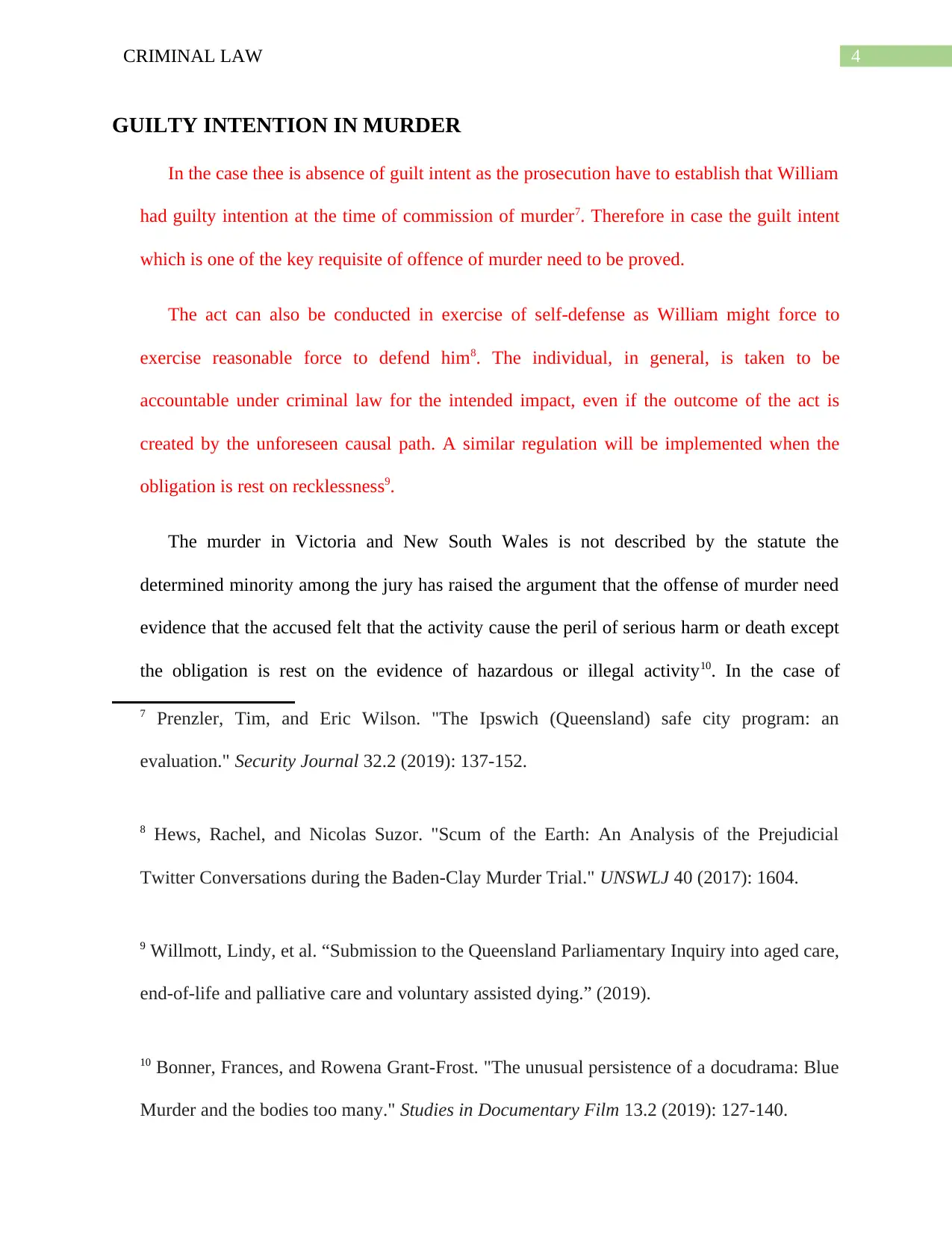
4CRIMINAL LAW
GUILTY INTENTION IN MURDER
In the case thee is absence of guilt intent as the prosecution have to establish that William
had guilty intention at the time of commission of murder7. Therefore in case the guilt intent
which is one of the key requisite of offence of murder need to be proved.
The act can also be conducted in exercise of self-defense as William might force to
exercise reasonable force to defend him8. The individual, in general, is taken to be
accountable under criminal law for the intended impact, even if the outcome of the act is
created by the unforeseen causal path. A similar regulation will be implemented when the
obligation is rest on recklessness9.
The murder in Victoria and New South Wales is not described by the statute the
determined minority among the jury has raised the argument that the offense of murder need
evidence that the accused felt that the activity cause the peril of serious harm or death except
the obligation is rest on the evidence of hazardous or illegal activity10. In the case of
7 Prenzler, Tim, and Eric Wilson. "The Ipswich (Queensland) safe city program: an
evaluation." Security Journal 32.2 (2019): 137-152.
8 Hews, Rachel, and Nicolas Suzor. "Scum of the Earth: An Analysis of the Prejudicial
Twitter Conversations during the Baden-Clay Murder Trial." UNSWLJ 40 (2017): 1604.
9 Willmott, Lindy, et al. “Submission to the Queensland Parliamentary Inquiry into aged care,
end-of-life and palliative care and voluntary assisted dying.” (2019).
10 Bonner, Frances, and Rowena Grant-Frost. "The unusual persistence of a docudrama: Blue
Murder and the bodies too many." Studies in Documentary Film 13.2 (2019): 127-140.
GUILTY INTENTION IN MURDER
In the case thee is absence of guilt intent as the prosecution have to establish that William
had guilty intention at the time of commission of murder7. Therefore in case the guilt intent
which is one of the key requisite of offence of murder need to be proved.
The act can also be conducted in exercise of self-defense as William might force to
exercise reasonable force to defend him8. The individual, in general, is taken to be
accountable under criminal law for the intended impact, even if the outcome of the act is
created by the unforeseen causal path. A similar regulation will be implemented when the
obligation is rest on recklessness9.
The murder in Victoria and New South Wales is not described by the statute the
determined minority among the jury has raised the argument that the offense of murder need
evidence that the accused felt that the activity cause the peril of serious harm or death except
the obligation is rest on the evidence of hazardous or illegal activity10. In the case of
7 Prenzler, Tim, and Eric Wilson. "The Ipswich (Queensland) safe city program: an
evaluation." Security Journal 32.2 (2019): 137-152.
8 Hews, Rachel, and Nicolas Suzor. "Scum of the Earth: An Analysis of the Prejudicial
Twitter Conversations during the Baden-Clay Murder Trial." UNSWLJ 40 (2017): 1604.
9 Willmott, Lindy, et al. “Submission to the Queensland Parliamentary Inquiry into aged care,
end-of-life and palliative care and voluntary assisted dying.” (2019).
10 Bonner, Frances, and Rowena Grant-Frost. "The unusual persistence of a docudrama: Blue
Murder and the bodies too many." Studies in Documentary Film 13.2 (2019): 127-140.
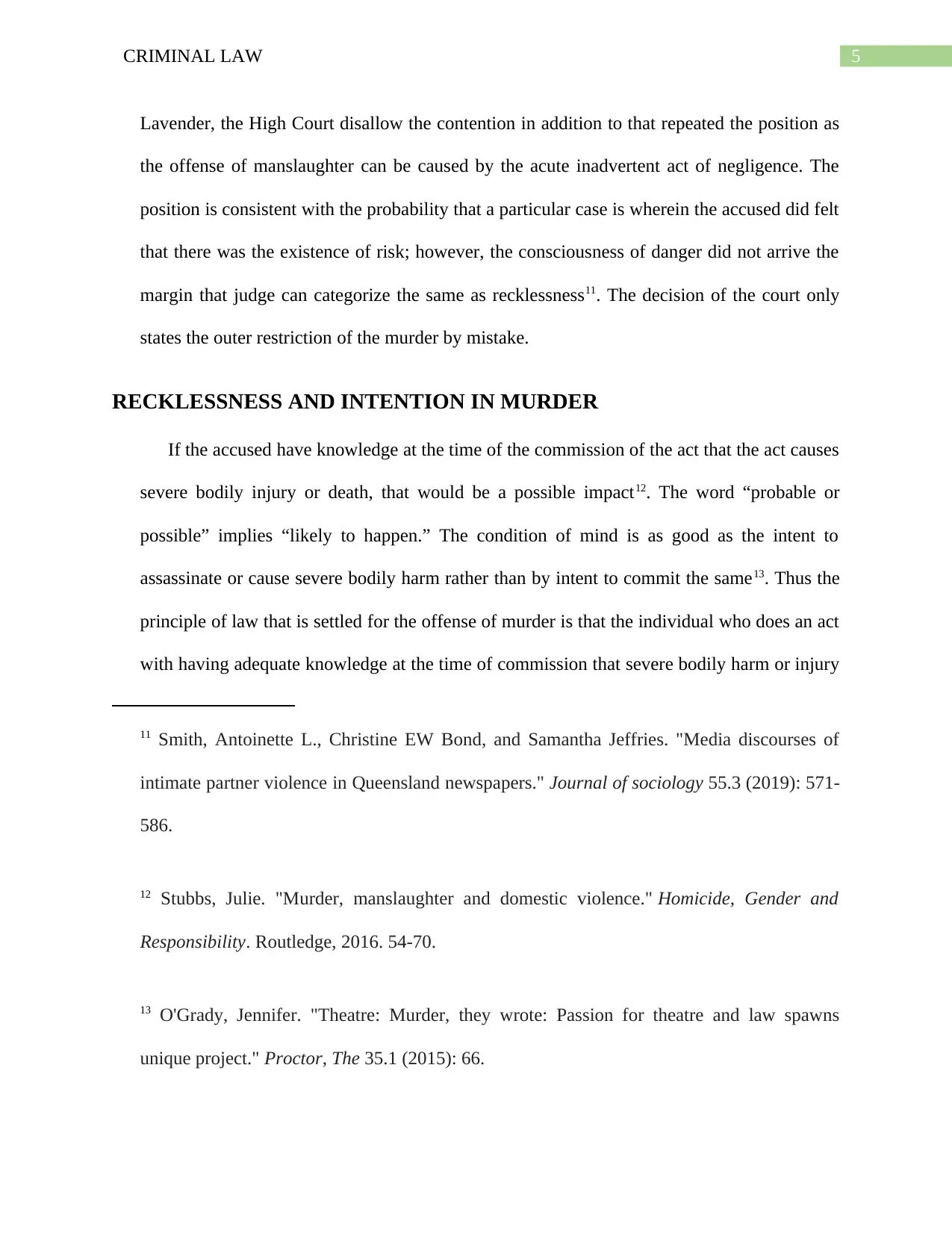
5CRIMINAL LAW
Lavender, the High Court disallow the contention in addition to that repeated the position as
the offense of manslaughter can be caused by the acute inadvertent act of negligence. The
position is consistent with the probability that a particular case is wherein the accused did felt
that there was the existence of risk; however, the consciousness of danger did not arrive the
margin that judge can categorize the same as recklessness11. The decision of the court only
states the outer restriction of the murder by mistake.
RECKLESSNESS AND INTENTION IN MURDER
If the accused have knowledge at the time of the commission of the act that the act causes
severe bodily injury or death, that would be a possible impact12. The word “probable or
possible” implies “likely to happen.” The condition of mind is as good as the intent to
assassinate or cause severe bodily harm rather than by intent to commit the same13. Thus the
principle of law that is settled for the offense of murder is that the individual who does an act
with having adequate knowledge at the time of commission that severe bodily harm or injury
11 Smith, Antoinette L., Christine EW Bond, and Samantha Jeffries. "Media discourses of
intimate partner violence in Queensland newspapers." Journal of sociology 55.3 (2019): 571-
586.
12 Stubbs, Julie. "Murder, manslaughter and domestic violence." Homicide, Gender and
Responsibility. Routledge, 2016. 54-70.
13 O'Grady, Jennifer. "Theatre: Murder, they wrote: Passion for theatre and law spawns
unique project." Proctor, The 35.1 (2015): 66.
Lavender, the High Court disallow the contention in addition to that repeated the position as
the offense of manslaughter can be caused by the acute inadvertent act of negligence. The
position is consistent with the probability that a particular case is wherein the accused did felt
that there was the existence of risk; however, the consciousness of danger did not arrive the
margin that judge can categorize the same as recklessness11. The decision of the court only
states the outer restriction of the murder by mistake.
RECKLESSNESS AND INTENTION IN MURDER
If the accused have knowledge at the time of the commission of the act that the act causes
severe bodily injury or death, that would be a possible impact12. The word “probable or
possible” implies “likely to happen.” The condition of mind is as good as the intent to
assassinate or cause severe bodily harm rather than by intent to commit the same13. Thus the
principle of law that is settled for the offense of murder is that the individual who does an act
with having adequate knowledge at the time of commission that severe bodily harm or injury
11 Smith, Antoinette L., Christine EW Bond, and Samantha Jeffries. "Media discourses of
intimate partner violence in Queensland newspapers." Journal of sociology 55.3 (2019): 571-
586.
12 Stubbs, Julie. "Murder, manslaughter and domestic violence." Homicide, Gender and
Responsibility. Routledge, 2016. 54-70.
13 O'Grady, Jennifer. "Theatre: Murder, they wrote: Passion for theatre and law spawns
unique project." Proctor, The 35.1 (2015): 66.
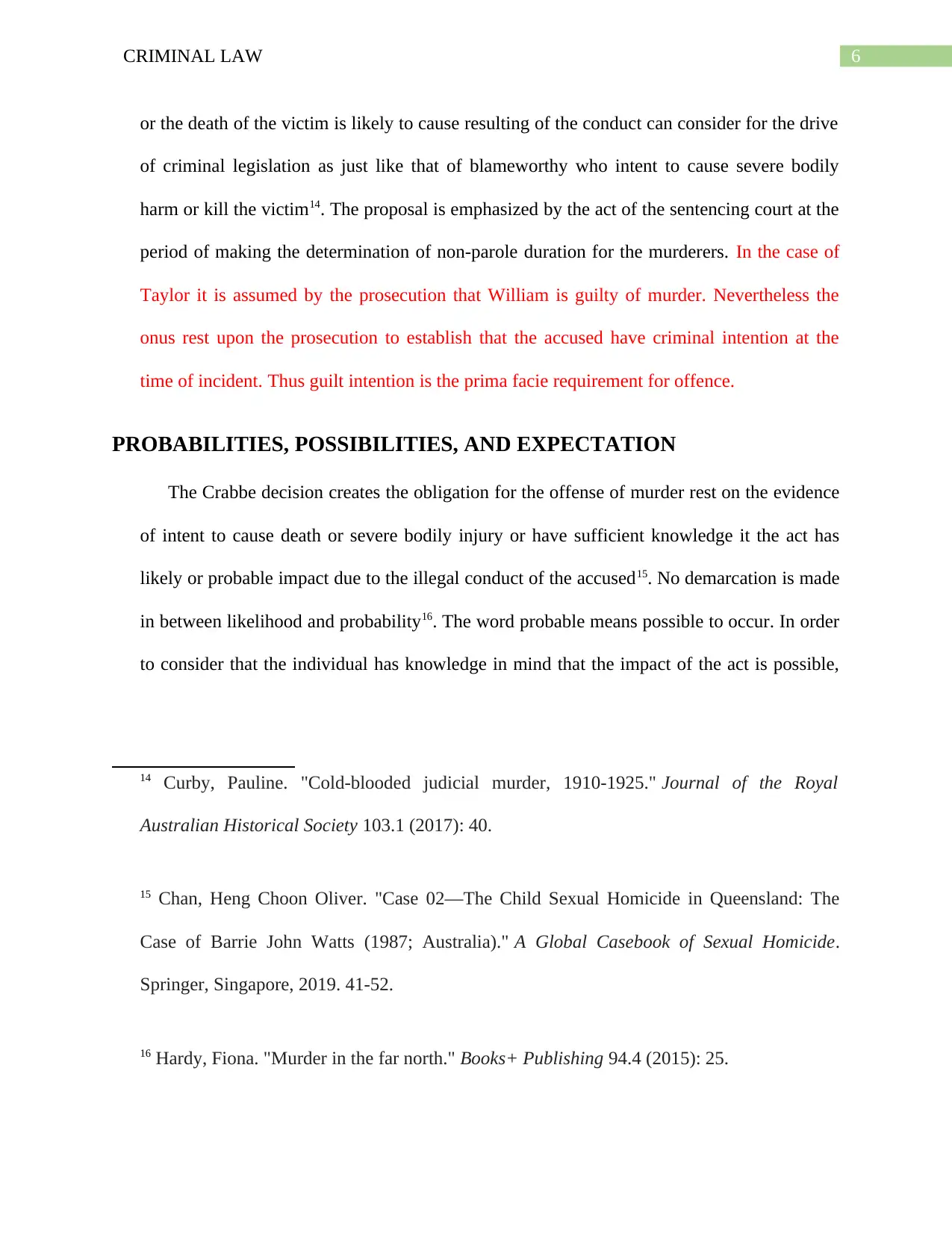
6CRIMINAL LAW
or the death of the victim is likely to cause resulting of the conduct can consider for the drive
of criminal legislation as just like that of blameworthy who intent to cause severe bodily
harm or kill the victim14. The proposal is emphasized by the act of the sentencing court at the
period of making the determination of non-parole duration for the murderers. In the case of
Taylor it is assumed by the prosecution that William is guilty of murder. Nevertheless the
onus rest upon the prosecution to establish that the accused have criminal intention at the
time of incident. Thus guilt intention is the prima facie requirement for offence.
PROBABILITIES, POSSIBILITIES, AND EXPECTATION
The Crabbe decision creates the obligation for the offense of murder rest on the evidence
of intent to cause death or severe bodily injury or have sufficient knowledge it the act has
likely or probable impact due to the illegal conduct of the accused15. No demarcation is made
in between likelihood and probability16. The word probable means possible to occur. In order
to consider that the individual has knowledge in mind that the impact of the act is possible,
14 Curby, Pauline. "Cold-blooded judicial murder, 1910-1925." Journal of the Royal
Australian Historical Society 103.1 (2017): 40.
15 Chan, Heng Choon Oliver. "Case 02—The Child Sexual Homicide in Queensland: The
Case of Barrie John Watts (1987; Australia)." A Global Casebook of Sexual Homicide.
Springer, Singapore, 2019. 41-52.
16 Hardy, Fiona. "Murder in the far north." Books+ Publishing 94.4 (2015): 25.
or the death of the victim is likely to cause resulting of the conduct can consider for the drive
of criminal legislation as just like that of blameworthy who intent to cause severe bodily
harm or kill the victim14. The proposal is emphasized by the act of the sentencing court at the
period of making the determination of non-parole duration for the murderers. In the case of
Taylor it is assumed by the prosecution that William is guilty of murder. Nevertheless the
onus rest upon the prosecution to establish that the accused have criminal intention at the
time of incident. Thus guilt intention is the prima facie requirement for offence.
PROBABILITIES, POSSIBILITIES, AND EXPECTATION
The Crabbe decision creates the obligation for the offense of murder rest on the evidence
of intent to cause death or severe bodily injury or have sufficient knowledge it the act has
likely or probable impact due to the illegal conduct of the accused15. No demarcation is made
in between likelihood and probability16. The word probable means possible to occur. In order
to consider that the individual has knowledge in mind that the impact of the act is possible,
14 Curby, Pauline. "Cold-blooded judicial murder, 1910-1925." Journal of the Royal
Australian Historical Society 103.1 (2017): 40.
15 Chan, Heng Choon Oliver. "Case 02—The Child Sexual Homicide in Queensland: The
Case of Barrie John Watts (1987; Australia)." A Global Casebook of Sexual Homicide.
Springer, Singapore, 2019. 41-52.
16 Hardy, Fiona. "Murder in the far north." Books+ Publishing 94.4 (2015): 25.
Paraphrase This Document
Need a fresh take? Get an instant paraphrase of this document with our AI Paraphraser
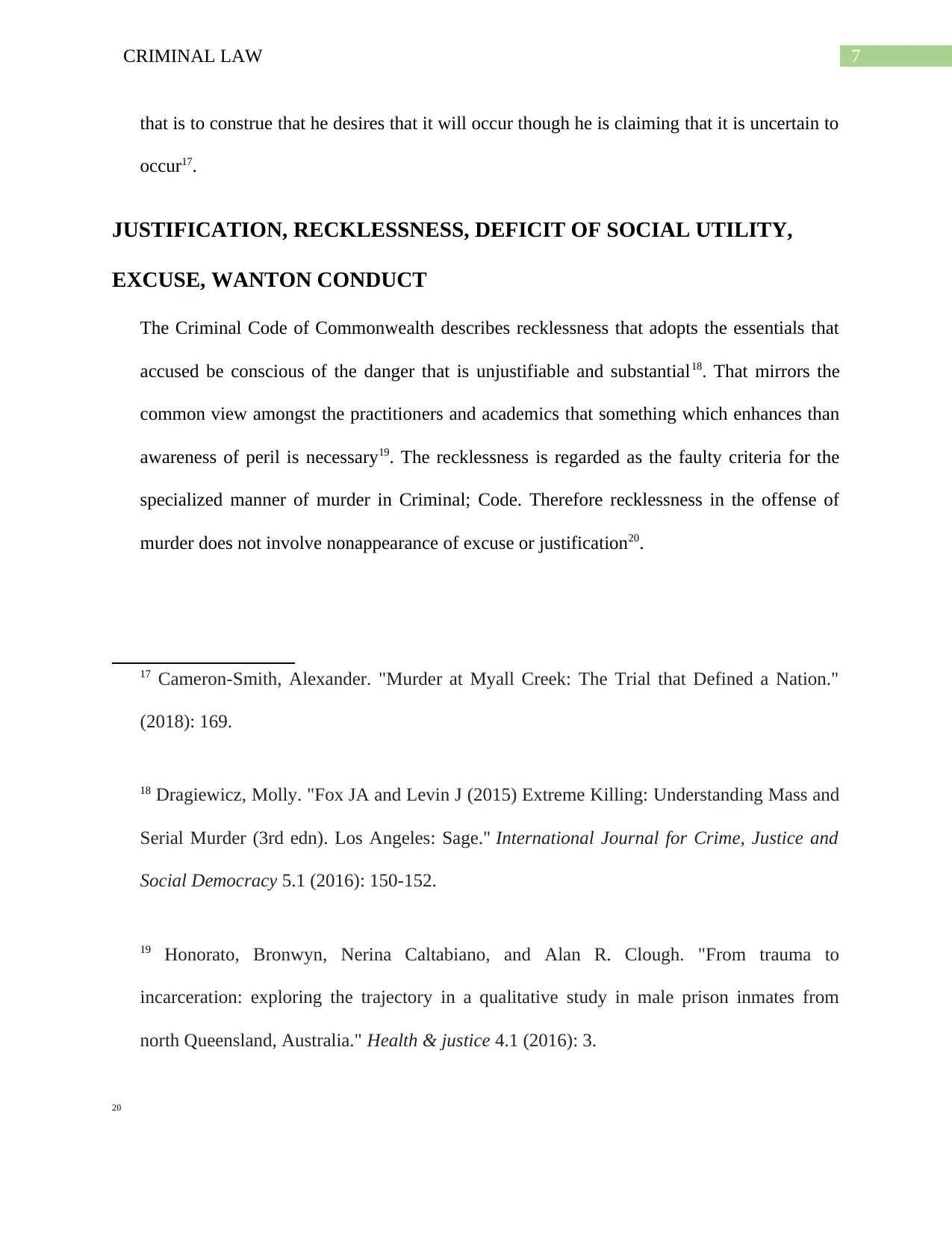
7CRIMINAL LAW
that is to construe that he desires that it will occur though he is claiming that it is uncertain to
occur17.
JUSTIFICATION, RECKLESSNESS, DEFICIT OF SOCIAL UTILITY,
EXCUSE, WANTON CONDUCT
The Criminal Code of Commonwealth describes recklessness that adopts the essentials that
accused be conscious of the danger that is unjustifiable and substantial18. That mirrors the
common view amongst the practitioners and academics that something which enhances than
awareness of peril is necessary19. The recklessness is regarded as the faulty criteria for the
specialized manner of murder in Criminal; Code. Therefore recklessness in the offense of
murder does not involve nonappearance of excuse or justification20.
17 Cameron-Smith, Alexander. "Murder at Myall Creek: The Trial that Defined a Nation."
(2018): 169.
18 Dragiewicz, Molly. "Fox JA and Levin J (2015) Extreme Killing: Understanding Mass and
Serial Murder (3rd edn). Los Angeles: Sage." International Journal for Crime, Justice and
Social Democracy 5.1 (2016): 150-152.
19 Honorato, Bronwyn, Nerina Caltabiano, and Alan R. Clough. "From trauma to
incarceration: exploring the trajectory in a qualitative study in male prison inmates from
north Queensland, Australia." Health & justice 4.1 (2016): 3.
20
that is to construe that he desires that it will occur though he is claiming that it is uncertain to
occur17.
JUSTIFICATION, RECKLESSNESS, DEFICIT OF SOCIAL UTILITY,
EXCUSE, WANTON CONDUCT
The Criminal Code of Commonwealth describes recklessness that adopts the essentials that
accused be conscious of the danger that is unjustifiable and substantial18. That mirrors the
common view amongst the practitioners and academics that something which enhances than
awareness of peril is necessary19. The recklessness is regarded as the faulty criteria for the
specialized manner of murder in Criminal; Code. Therefore recklessness in the offense of
murder does not involve nonappearance of excuse or justification20.
17 Cameron-Smith, Alexander. "Murder at Myall Creek: The Trial that Defined a Nation."
(2018): 169.
18 Dragiewicz, Molly. "Fox JA and Levin J (2015) Extreme Killing: Understanding Mass and
Serial Murder (3rd edn). Los Angeles: Sage." International Journal for Crime, Justice and
Social Democracy 5.1 (2016): 150-152.
19 Honorato, Bronwyn, Nerina Caltabiano, and Alan R. Clough. "From trauma to
incarceration: exploring the trajectory in a qualitative study in male prison inmates from
north Queensland, Australia." Health & justice 4.1 (2016): 3.
20
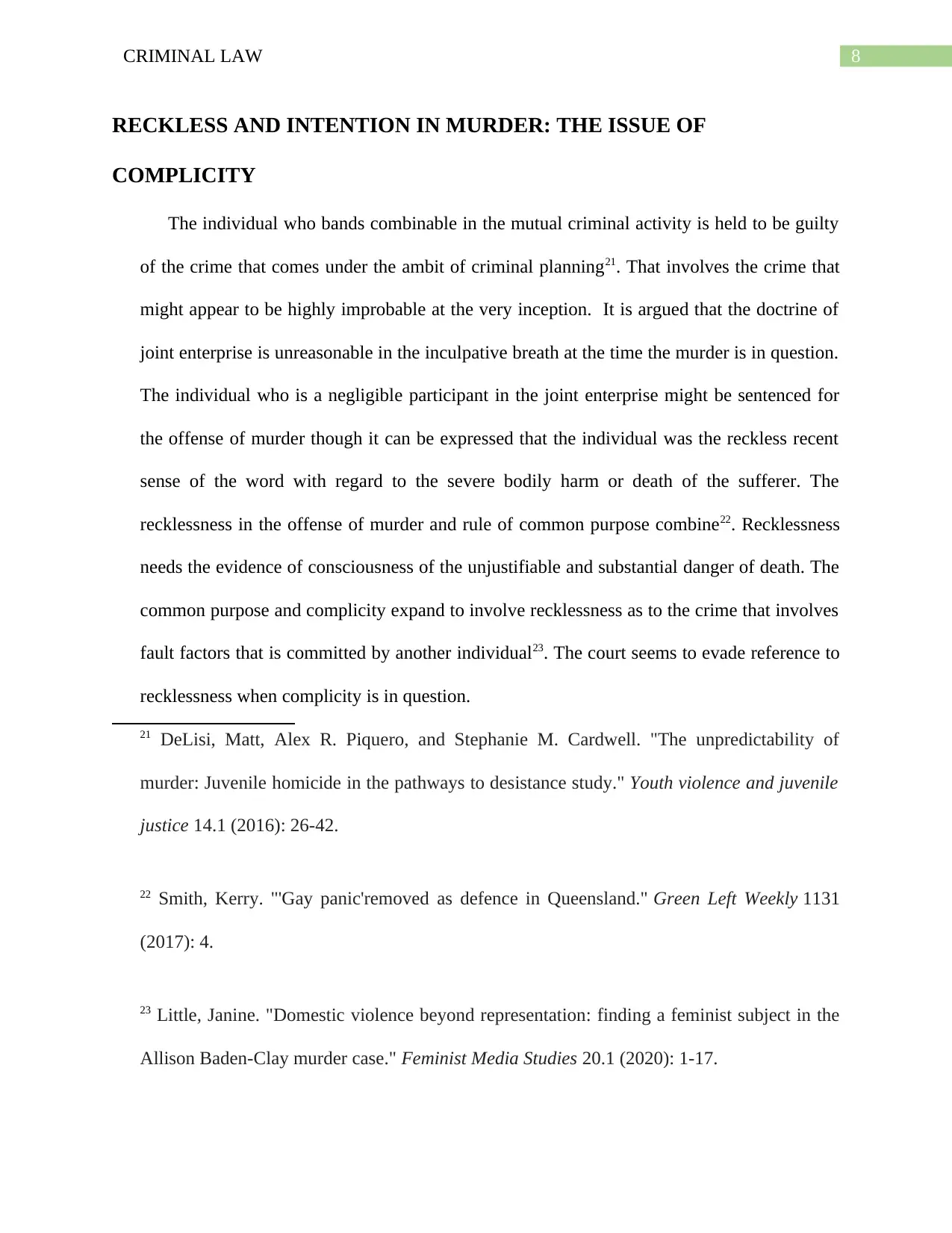
8CRIMINAL LAW
RECKLESS AND INTENTION IN MURDER: THE ISSUE OF
COMPLICITY
The individual who bands combinable in the mutual criminal activity is held to be guilty
of the crime that comes under the ambit of criminal planning21. That involves the crime that
might appear to be highly improbable at the very inception. It is argued that the doctrine of
joint enterprise is unreasonable in the inculpative breath at the time the murder is in question.
The individual who is a negligible participant in the joint enterprise might be sentenced for
the offense of murder though it can be expressed that the individual was the reckless recent
sense of the word with regard to the severe bodily harm or death of the sufferer. The
recklessness in the offense of murder and rule of common purpose combine22. Recklessness
needs the evidence of consciousness of the unjustifiable and substantial danger of death. The
common purpose and complicity expand to involve recklessness as to the crime that involves
fault factors that is committed by another individual23. The court seems to evade reference to
recklessness when complicity is in question.
21 DeLisi, Matt, Alex R. Piquero, and Stephanie M. Cardwell. "The unpredictability of
murder: Juvenile homicide in the pathways to desistance study." Youth violence and juvenile
justice 14.1 (2016): 26-42.
22 Smith, Kerry. "'Gay panic'removed as defence in Queensland." Green Left Weekly 1131
(2017): 4.
23 Little, Janine. "Domestic violence beyond representation: finding a feminist subject in the
Allison Baden-Clay murder case." Feminist Media Studies 20.1 (2020): 1-17.
RECKLESS AND INTENTION IN MURDER: THE ISSUE OF
COMPLICITY
The individual who bands combinable in the mutual criminal activity is held to be guilty
of the crime that comes under the ambit of criminal planning21. That involves the crime that
might appear to be highly improbable at the very inception. It is argued that the doctrine of
joint enterprise is unreasonable in the inculpative breath at the time the murder is in question.
The individual who is a negligible participant in the joint enterprise might be sentenced for
the offense of murder though it can be expressed that the individual was the reckless recent
sense of the word with regard to the severe bodily harm or death of the sufferer. The
recklessness in the offense of murder and rule of common purpose combine22. Recklessness
needs the evidence of consciousness of the unjustifiable and substantial danger of death. The
common purpose and complicity expand to involve recklessness as to the crime that involves
fault factors that is committed by another individual23. The court seems to evade reference to
recklessness when complicity is in question.
21 DeLisi, Matt, Alex R. Piquero, and Stephanie M. Cardwell. "The unpredictability of
murder: Juvenile homicide in the pathways to desistance study." Youth violence and juvenile
justice 14.1 (2016): 26-42.
22 Smith, Kerry. "'Gay panic'removed as defence in Queensland." Green Left Weekly 1131
(2017): 4.
23 Little, Janine. "Domestic violence beyond representation: finding a feminist subject in the
Allison Baden-Clay murder case." Feminist Media Studies 20.1 (2020): 1-17.
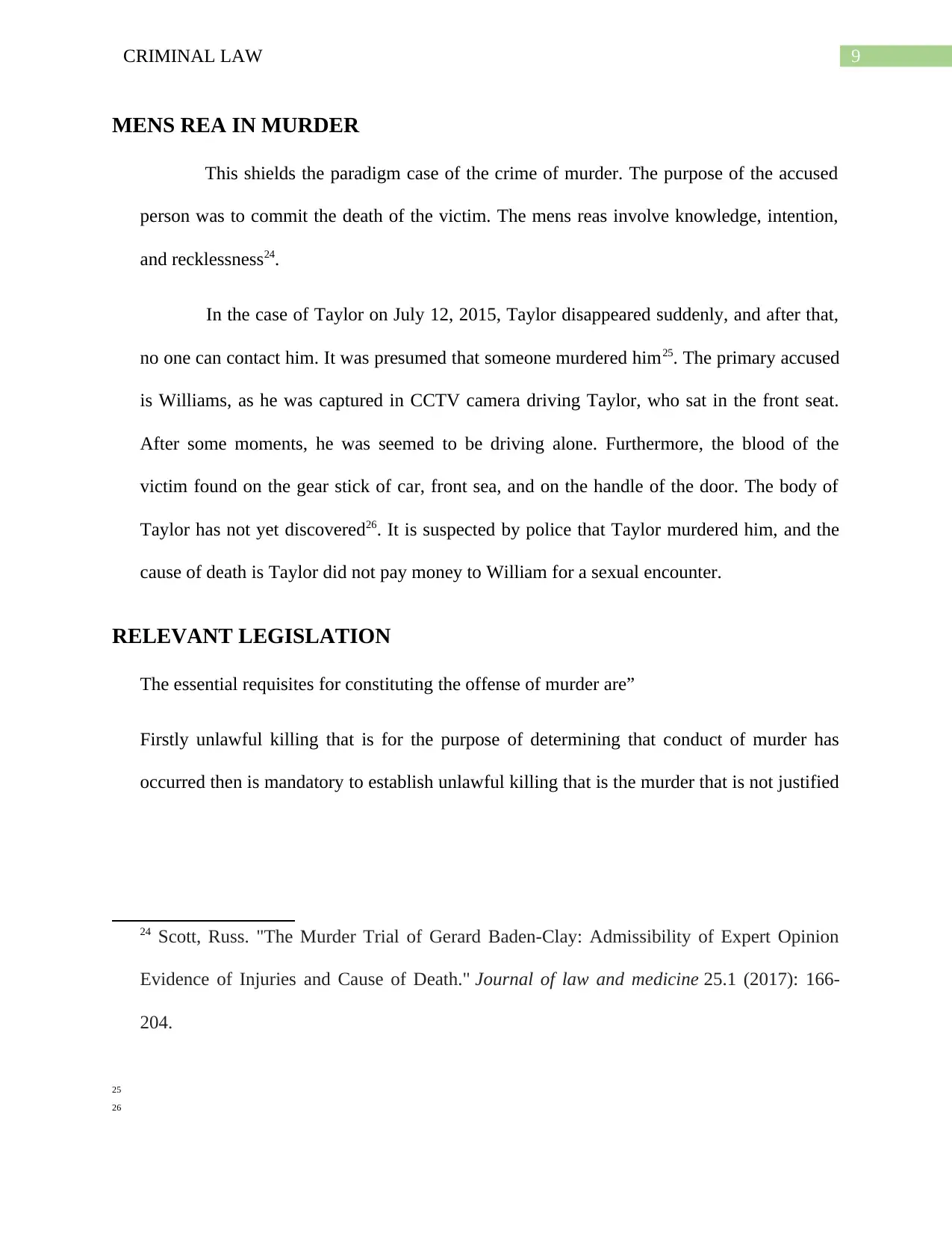
9CRIMINAL LAW
MENS REA IN MURDER
This shields the paradigm case of the crime of murder. The purpose of the accused
person was to commit the death of the victim. The mens reas involve knowledge, intention,
and recklessness24.
In the case of Taylor on July 12, 2015, Taylor disappeared suddenly, and after that,
no one can contact him. It was presumed that someone murdered him25. The primary accused
is Williams, as he was captured in CCTV camera driving Taylor, who sat in the front seat.
After some moments, he was seemed to be driving alone. Furthermore, the blood of the
victim found on the gear stick of car, front sea, and on the handle of the door. The body of
Taylor has not yet discovered26. It is suspected by police that Taylor murdered him, and the
cause of death is Taylor did not pay money to William for a sexual encounter.
RELEVANT LEGISLATION
The essential requisites for constituting the offense of murder are”
Firstly unlawful killing that is for the purpose of determining that conduct of murder has
occurred then is mandatory to establish unlawful killing that is the murder that is not justified
24 Scott, Russ. "The Murder Trial of Gerard Baden-Clay: Admissibility of Expert Opinion
Evidence of Injuries and Cause of Death." Journal of law and medicine 25.1 (2017): 166-
204.
25
26
MENS REA IN MURDER
This shields the paradigm case of the crime of murder. The purpose of the accused
person was to commit the death of the victim. The mens reas involve knowledge, intention,
and recklessness24.
In the case of Taylor on July 12, 2015, Taylor disappeared suddenly, and after that,
no one can contact him. It was presumed that someone murdered him25. The primary accused
is Williams, as he was captured in CCTV camera driving Taylor, who sat in the front seat.
After some moments, he was seemed to be driving alone. Furthermore, the blood of the
victim found on the gear stick of car, front sea, and on the handle of the door. The body of
Taylor has not yet discovered26. It is suspected by police that Taylor murdered him, and the
cause of death is Taylor did not pay money to William for a sexual encounter.
RELEVANT LEGISLATION
The essential requisites for constituting the offense of murder are”
Firstly unlawful killing that is for the purpose of determining that conduct of murder has
occurred then is mandatory to establish unlawful killing that is the murder that is not justified
24 Scott, Russ. "The Murder Trial of Gerard Baden-Clay: Admissibility of Expert Opinion
Evidence of Injuries and Cause of Death." Journal of law and medicine 25.1 (2017): 166-
204.
25
26
Secure Best Marks with AI Grader
Need help grading? Try our AI Grader for instant feedback on your assignments.
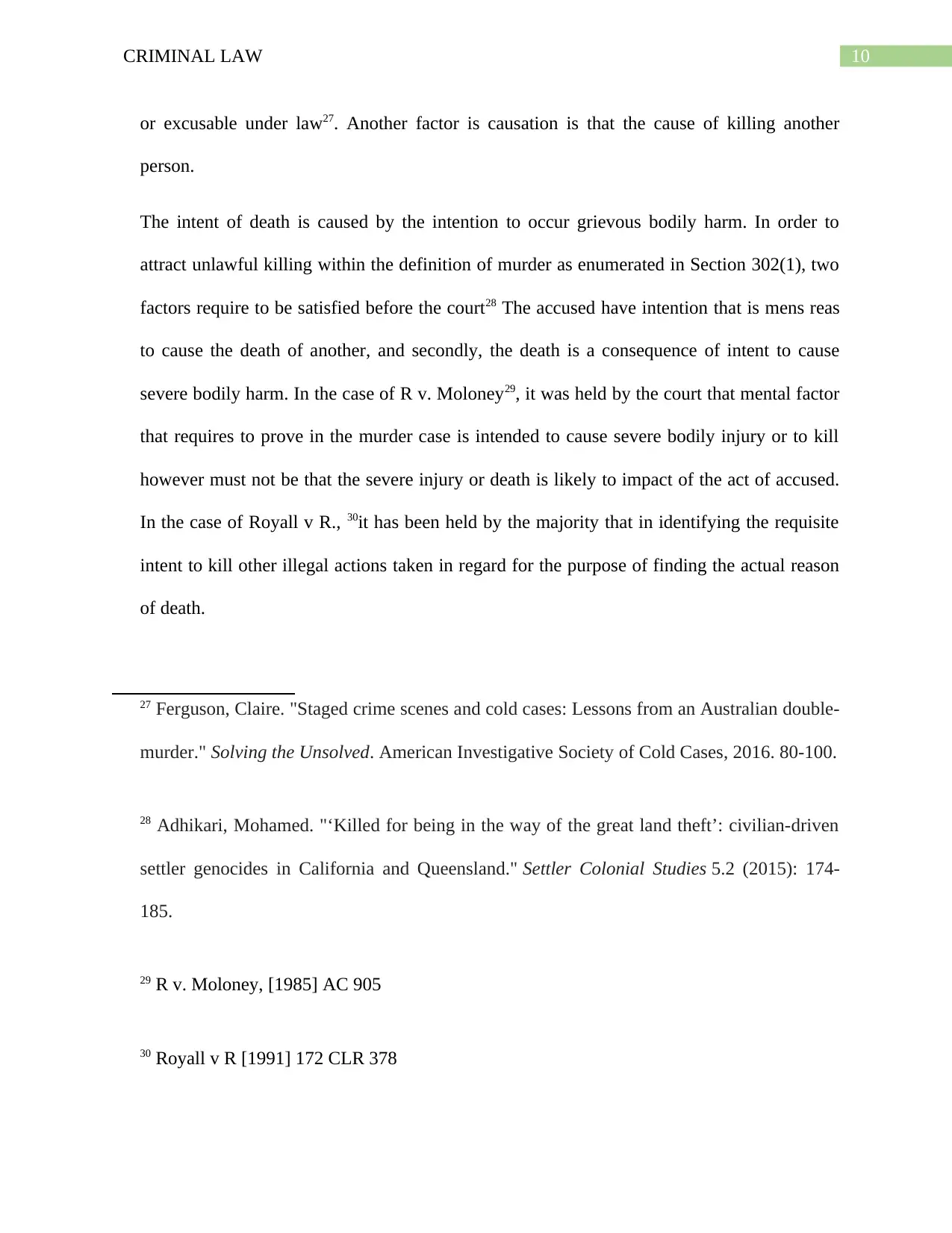
10CRIMINAL LAW
or excusable under law27. Another factor is causation is that the cause of killing another
person.
The intent of death is caused by the intention to occur grievous bodily harm. In order to
attract unlawful killing within the definition of murder as enumerated in Section 302(1), two
factors require to be satisfied before the court28 The accused have intention that is mens reas
to cause the death of another, and secondly, the death is a consequence of intent to cause
severe bodily harm. In the case of R v. Moloney29, it was held by the court that mental factor
that requires to prove in the murder case is intended to cause severe bodily injury or to kill
however must not be that the severe injury or death is likely to impact of the act of accused.
In the case of Royall v R., 30it has been held by the majority that in identifying the requisite
intent to kill other illegal actions taken in regard for the purpose of finding the actual reason
of death.
27 Ferguson, Claire. "Staged crime scenes and cold cases: Lessons from an Australian double-
murder." Solving the Unsolved. American Investigative Society of Cold Cases, 2016. 80-100.
28 Adhikari, Mohamed. "‘Killed for being in the way of the great land theft’: civilian-driven
settler genocides in California and Queensland." Settler Colonial Studies 5.2 (2015): 174-
185.
29 R v. Moloney, [1985] AC 905
30 Royall v R [1991] 172 CLR 378
or excusable under law27. Another factor is causation is that the cause of killing another
person.
The intent of death is caused by the intention to occur grievous bodily harm. In order to
attract unlawful killing within the definition of murder as enumerated in Section 302(1), two
factors require to be satisfied before the court28 The accused have intention that is mens reas
to cause the death of another, and secondly, the death is a consequence of intent to cause
severe bodily harm. In the case of R v. Moloney29, it was held by the court that mental factor
that requires to prove in the murder case is intended to cause severe bodily injury or to kill
however must not be that the severe injury or death is likely to impact of the act of accused.
In the case of Royall v R., 30it has been held by the majority that in identifying the requisite
intent to kill other illegal actions taken in regard for the purpose of finding the actual reason
of death.
27 Ferguson, Claire. "Staged crime scenes and cold cases: Lessons from an Australian double-
murder." Solving the Unsolved. American Investigative Society of Cold Cases, 2016. 80-100.
28 Adhikari, Mohamed. "‘Killed for being in the way of the great land theft’: civilian-driven
settler genocides in California and Queensland." Settler Colonial Studies 5.2 (2015): 174-
185.
29 R v. Moloney, [1985] AC 905
30 Royall v R [1991] 172 CLR 378

11CRIMINAL LAW
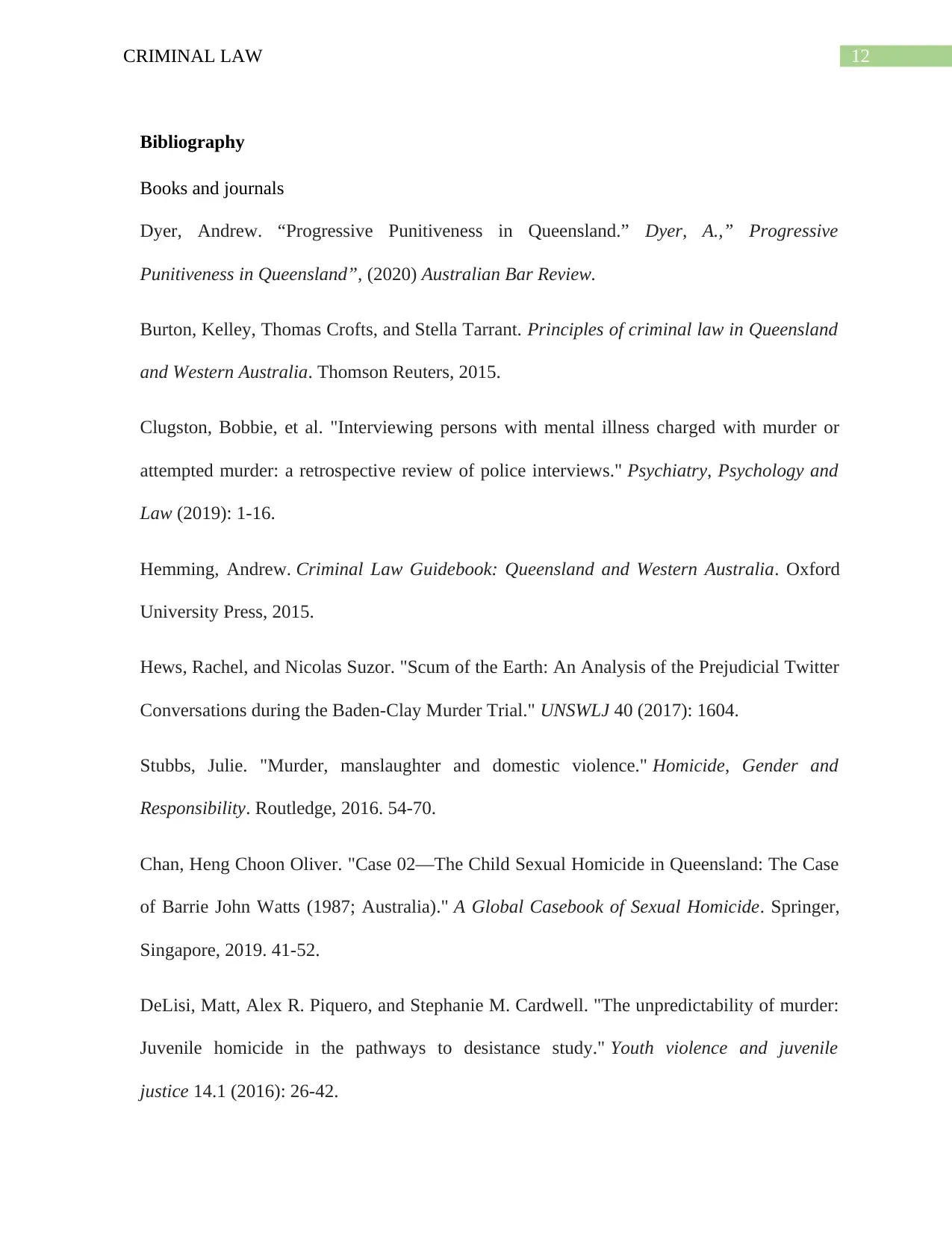
12CRIMINAL LAW
Bibliography
Books and journals
Dyer, Andrew. “Progressive Punitiveness in Queensland.” Dyer, A.,” Progressive
Punitiveness in Queensland”, (2020) Australian Bar Review.
Burton, Kelley, Thomas Crofts, and Stella Tarrant. Principles of criminal law in Queensland
and Western Australia. Thomson Reuters, 2015.
Clugston, Bobbie, et al. "Interviewing persons with mental illness charged with murder or
attempted murder: a retrospective review of police interviews." Psychiatry, Psychology and
Law (2019): 1-16.
Hemming, Andrew. Criminal Law Guidebook: Queensland and Western Australia. Oxford
University Press, 2015.
Hews, Rachel, and Nicolas Suzor. "Scum of the Earth: An Analysis of the Prejudicial Twitter
Conversations during the Baden-Clay Murder Trial." UNSWLJ 40 (2017): 1604.
Stubbs, Julie. "Murder, manslaughter and domestic violence." Homicide, Gender and
Responsibility. Routledge, 2016. 54-70.
Chan, Heng Choon Oliver. "Case 02—The Child Sexual Homicide in Queensland: The Case
of Barrie John Watts (1987; Australia)." A Global Casebook of Sexual Homicide. Springer,
Singapore, 2019. 41-52.
DeLisi, Matt, Alex R. Piquero, and Stephanie M. Cardwell. "The unpredictability of murder:
Juvenile homicide in the pathways to desistance study." Youth violence and juvenile
justice 14.1 (2016): 26-42.
Bibliography
Books and journals
Dyer, Andrew. “Progressive Punitiveness in Queensland.” Dyer, A.,” Progressive
Punitiveness in Queensland”, (2020) Australian Bar Review.
Burton, Kelley, Thomas Crofts, and Stella Tarrant. Principles of criminal law in Queensland
and Western Australia. Thomson Reuters, 2015.
Clugston, Bobbie, et al. "Interviewing persons with mental illness charged with murder or
attempted murder: a retrospective review of police interviews." Psychiatry, Psychology and
Law (2019): 1-16.
Hemming, Andrew. Criminal Law Guidebook: Queensland and Western Australia. Oxford
University Press, 2015.
Hews, Rachel, and Nicolas Suzor. "Scum of the Earth: An Analysis of the Prejudicial Twitter
Conversations during the Baden-Clay Murder Trial." UNSWLJ 40 (2017): 1604.
Stubbs, Julie. "Murder, manslaughter and domestic violence." Homicide, Gender and
Responsibility. Routledge, 2016. 54-70.
Chan, Heng Choon Oliver. "Case 02—The Child Sexual Homicide in Queensland: The Case
of Barrie John Watts (1987; Australia)." A Global Casebook of Sexual Homicide. Springer,
Singapore, 2019. 41-52.
DeLisi, Matt, Alex R. Piquero, and Stephanie M. Cardwell. "The unpredictability of murder:
Juvenile homicide in the pathways to desistance study." Youth violence and juvenile
justice 14.1 (2016): 26-42.
Paraphrase This Document
Need a fresh take? Get an instant paraphrase of this document with our AI Paraphraser
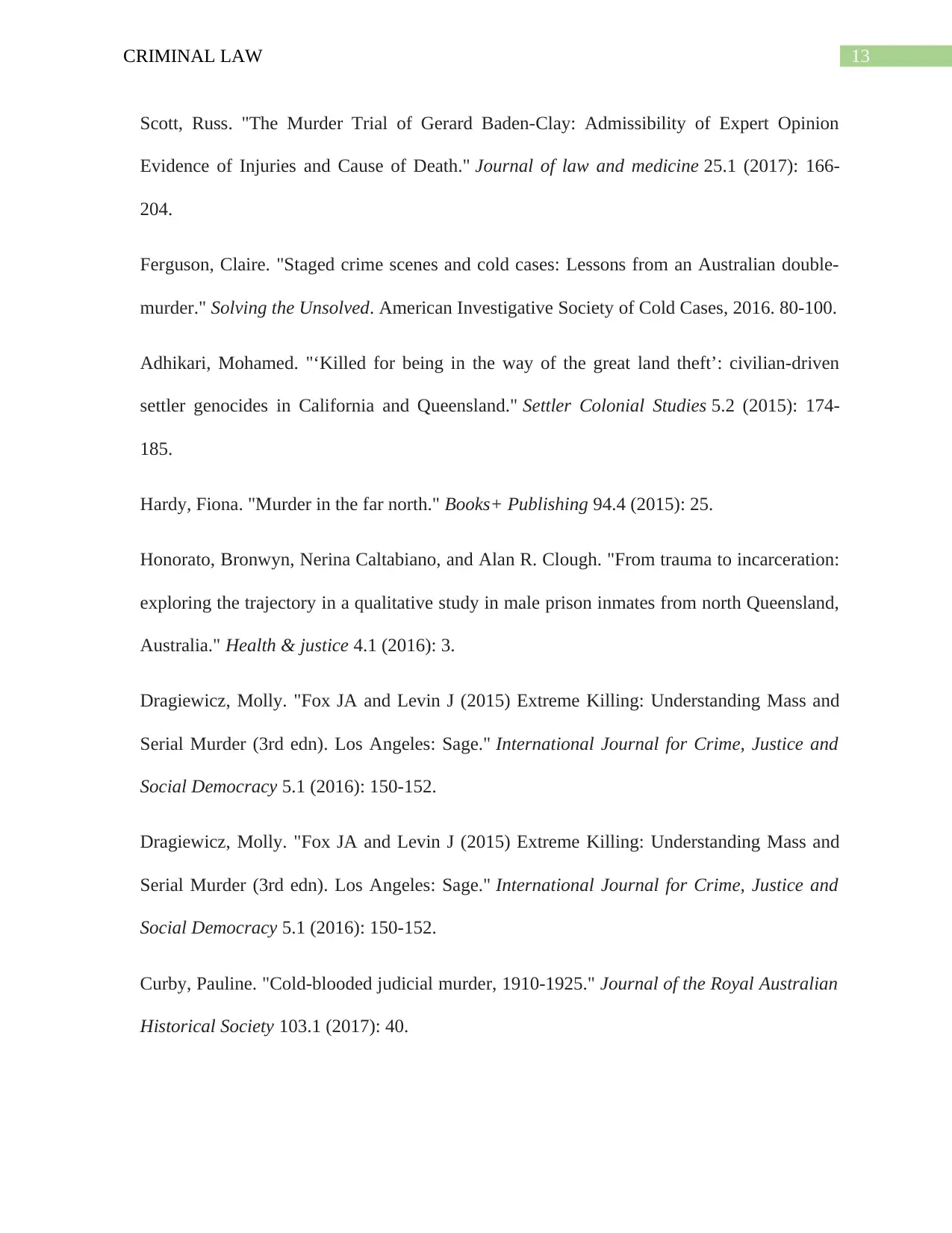
13CRIMINAL LAW
Scott, Russ. "The Murder Trial of Gerard Baden-Clay: Admissibility of Expert Opinion
Evidence of Injuries and Cause of Death." Journal of law and medicine 25.1 (2017): 166-
204.
Ferguson, Claire. "Staged crime scenes and cold cases: Lessons from an Australian double-
murder." Solving the Unsolved. American Investigative Society of Cold Cases, 2016. 80-100.
Adhikari, Mohamed. "‘Killed for being in the way of the great land theft’: civilian-driven
settler genocides in California and Queensland." Settler Colonial Studies 5.2 (2015): 174-
185.
Hardy, Fiona. "Murder in the far north." Books+ Publishing 94.4 (2015): 25.
Honorato, Bronwyn, Nerina Caltabiano, and Alan R. Clough. "From trauma to incarceration:
exploring the trajectory in a qualitative study in male prison inmates from north Queensland,
Australia." Health & justice 4.1 (2016): 3.
Dragiewicz, Molly. "Fox JA and Levin J (2015) Extreme Killing: Understanding Mass and
Serial Murder (3rd edn). Los Angeles: Sage." International Journal for Crime, Justice and
Social Democracy 5.1 (2016): 150-152.
Dragiewicz, Molly. "Fox JA and Levin J (2015) Extreme Killing: Understanding Mass and
Serial Murder (3rd edn). Los Angeles: Sage." International Journal for Crime, Justice and
Social Democracy 5.1 (2016): 150-152.
Curby, Pauline. "Cold-blooded judicial murder, 1910-1925." Journal of the Royal Australian
Historical Society 103.1 (2017): 40.
Scott, Russ. "The Murder Trial of Gerard Baden-Clay: Admissibility of Expert Opinion
Evidence of Injuries and Cause of Death." Journal of law and medicine 25.1 (2017): 166-
204.
Ferguson, Claire. "Staged crime scenes and cold cases: Lessons from an Australian double-
murder." Solving the Unsolved. American Investigative Society of Cold Cases, 2016. 80-100.
Adhikari, Mohamed. "‘Killed for being in the way of the great land theft’: civilian-driven
settler genocides in California and Queensland." Settler Colonial Studies 5.2 (2015): 174-
185.
Hardy, Fiona. "Murder in the far north." Books+ Publishing 94.4 (2015): 25.
Honorato, Bronwyn, Nerina Caltabiano, and Alan R. Clough. "From trauma to incarceration:
exploring the trajectory in a qualitative study in male prison inmates from north Queensland,
Australia." Health & justice 4.1 (2016): 3.
Dragiewicz, Molly. "Fox JA and Levin J (2015) Extreme Killing: Understanding Mass and
Serial Murder (3rd edn). Los Angeles: Sage." International Journal for Crime, Justice and
Social Democracy 5.1 (2016): 150-152.
Dragiewicz, Molly. "Fox JA and Levin J (2015) Extreme Killing: Understanding Mass and
Serial Murder (3rd edn). Los Angeles: Sage." International Journal for Crime, Justice and
Social Democracy 5.1 (2016): 150-152.
Curby, Pauline. "Cold-blooded judicial murder, 1910-1925." Journal of the Royal Australian
Historical Society 103.1 (2017): 40.
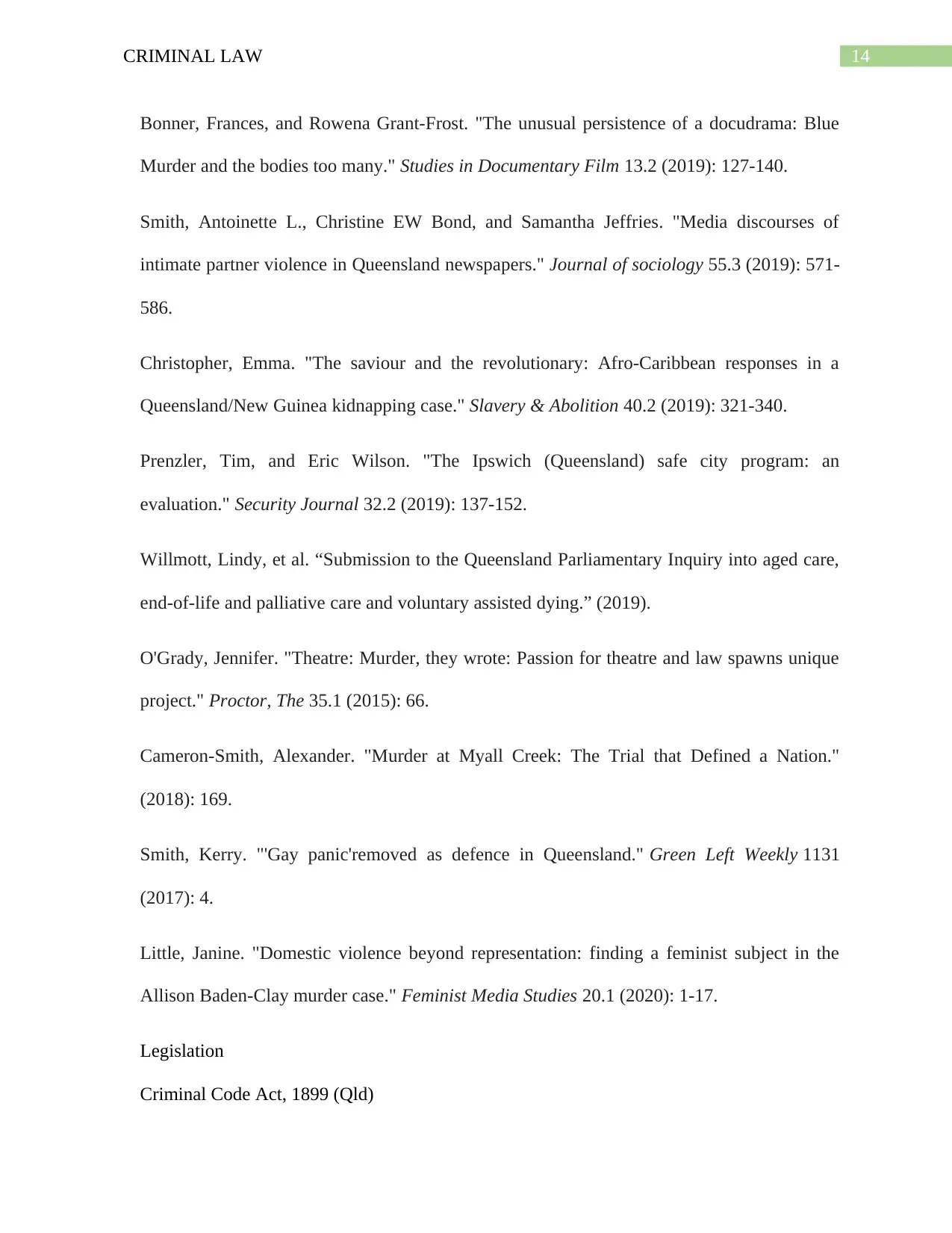
14CRIMINAL LAW
Bonner, Frances, and Rowena Grant-Frost. "The unusual persistence of a docudrama: Blue
Murder and the bodies too many." Studies in Documentary Film 13.2 (2019): 127-140.
Smith, Antoinette L., Christine EW Bond, and Samantha Jeffries. "Media discourses of
intimate partner violence in Queensland newspapers." Journal of sociology 55.3 (2019): 571-
586.
Christopher, Emma. "The saviour and the revolutionary: Afro-Caribbean responses in a
Queensland/New Guinea kidnapping case." Slavery & Abolition 40.2 (2019): 321-340.
Prenzler, Tim, and Eric Wilson. "The Ipswich (Queensland) safe city program: an
evaluation." Security Journal 32.2 (2019): 137-152.
Willmott, Lindy, et al. “Submission to the Queensland Parliamentary Inquiry into aged care,
end-of-life and palliative care and voluntary assisted dying.” (2019).
O'Grady, Jennifer. "Theatre: Murder, they wrote: Passion for theatre and law spawns unique
project." Proctor, The 35.1 (2015): 66.
Cameron-Smith, Alexander. "Murder at Myall Creek: The Trial that Defined a Nation."
(2018): 169.
Smith, Kerry. "'Gay panic'removed as defence in Queensland." Green Left Weekly 1131
(2017): 4.
Little, Janine. "Domestic violence beyond representation: finding a feminist subject in the
Allison Baden-Clay murder case." Feminist Media Studies 20.1 (2020): 1-17.
Legislation
Criminal Code Act, 1899 (Qld)
Bonner, Frances, and Rowena Grant-Frost. "The unusual persistence of a docudrama: Blue
Murder and the bodies too many." Studies in Documentary Film 13.2 (2019): 127-140.
Smith, Antoinette L., Christine EW Bond, and Samantha Jeffries. "Media discourses of
intimate partner violence in Queensland newspapers." Journal of sociology 55.3 (2019): 571-
586.
Christopher, Emma. "The saviour and the revolutionary: Afro-Caribbean responses in a
Queensland/New Guinea kidnapping case." Slavery & Abolition 40.2 (2019): 321-340.
Prenzler, Tim, and Eric Wilson. "The Ipswich (Queensland) safe city program: an
evaluation." Security Journal 32.2 (2019): 137-152.
Willmott, Lindy, et al. “Submission to the Queensland Parliamentary Inquiry into aged care,
end-of-life and palliative care and voluntary assisted dying.” (2019).
O'Grady, Jennifer. "Theatre: Murder, they wrote: Passion for theatre and law spawns unique
project." Proctor, The 35.1 (2015): 66.
Cameron-Smith, Alexander. "Murder at Myall Creek: The Trial that Defined a Nation."
(2018): 169.
Smith, Kerry. "'Gay panic'removed as defence in Queensland." Green Left Weekly 1131
(2017): 4.
Little, Janine. "Domestic violence beyond representation: finding a feminist subject in the
Allison Baden-Clay murder case." Feminist Media Studies 20.1 (2020): 1-17.
Legislation
Criminal Code Act, 1899 (Qld)

15CRIMINAL LAW
Case laws
R v. Moloney, [1985] AC 905
Royall v R [1991] 172 CLR 378
Case laws
R v. Moloney, [1985] AC 905
Royall v R [1991] 172 CLR 378
1 out of 16
Related Documents
Your All-in-One AI-Powered Toolkit for Academic Success.
+13062052269
info@desklib.com
Available 24*7 on WhatsApp / Email
![[object Object]](/_next/static/media/star-bottom.7253800d.svg)
Unlock your academic potential
© 2024 | Zucol Services PVT LTD | All rights reserved.




